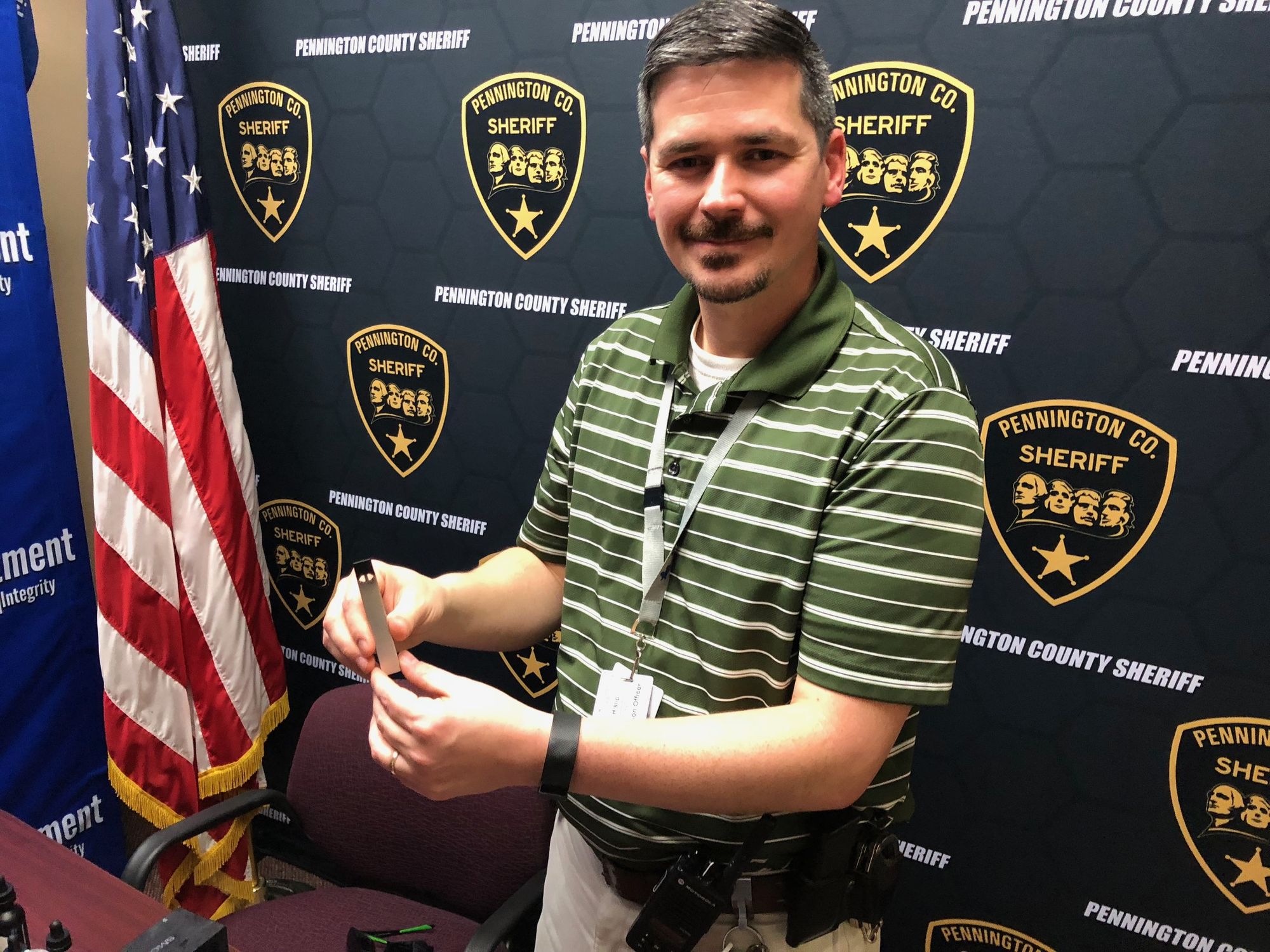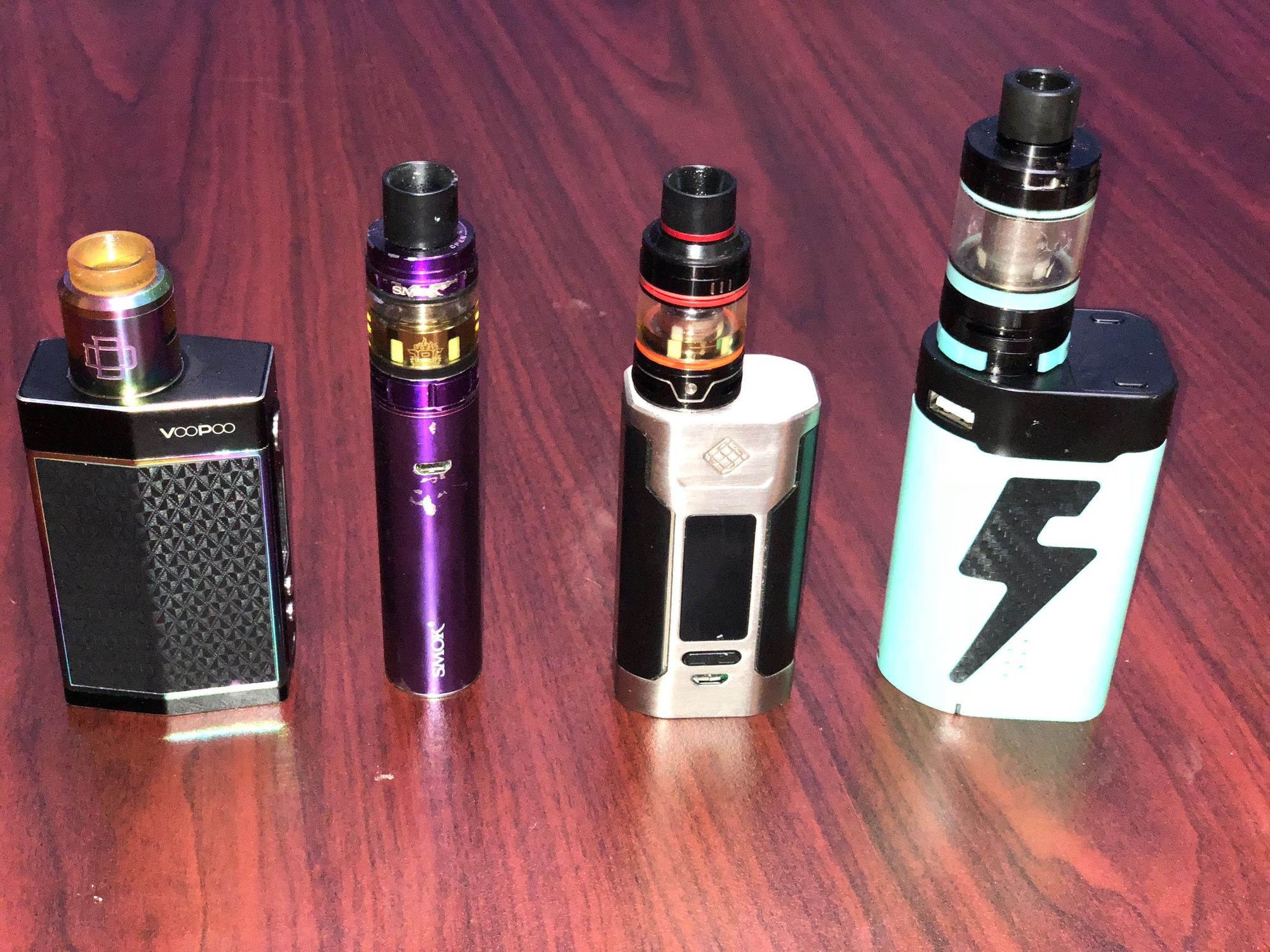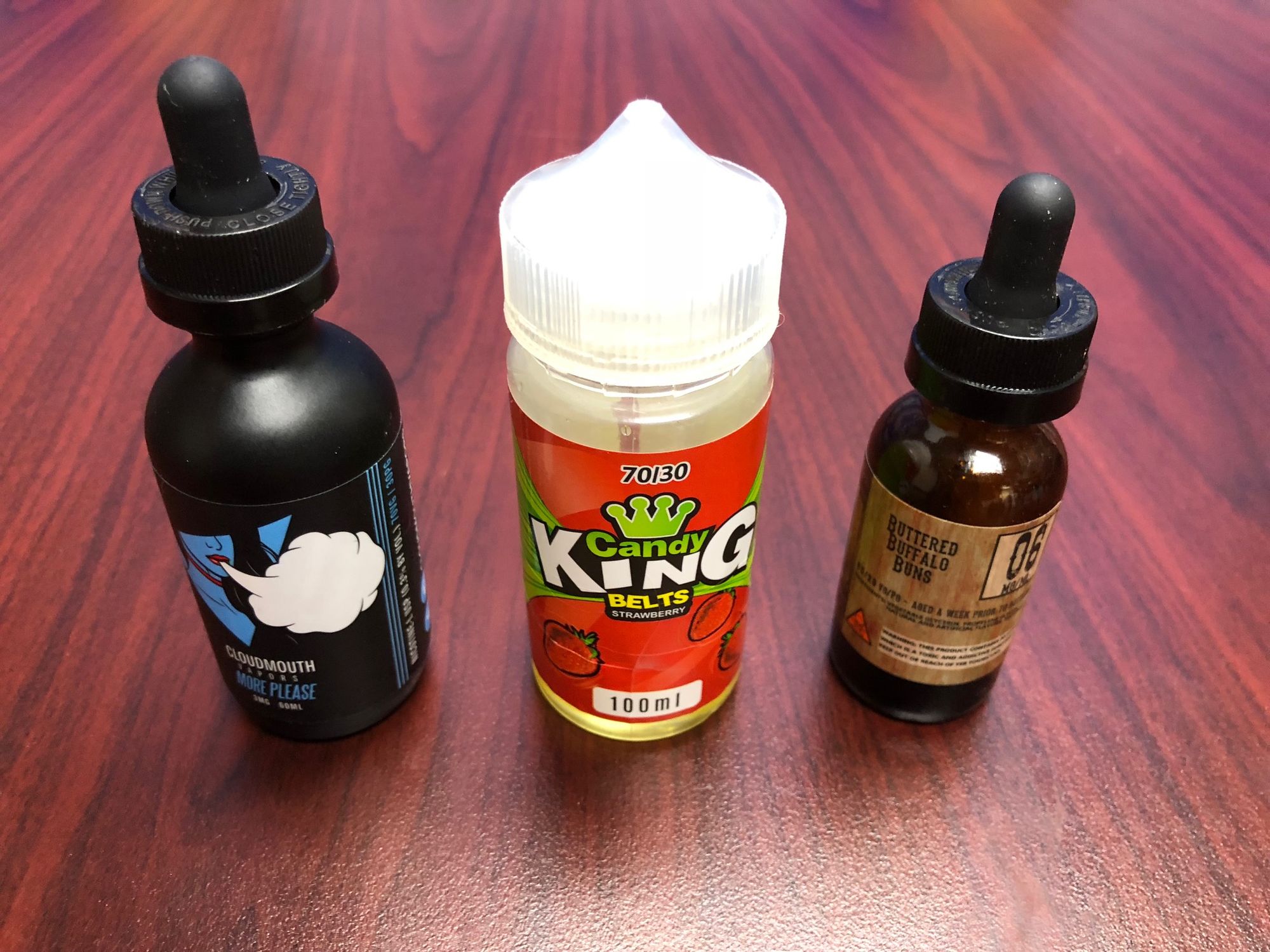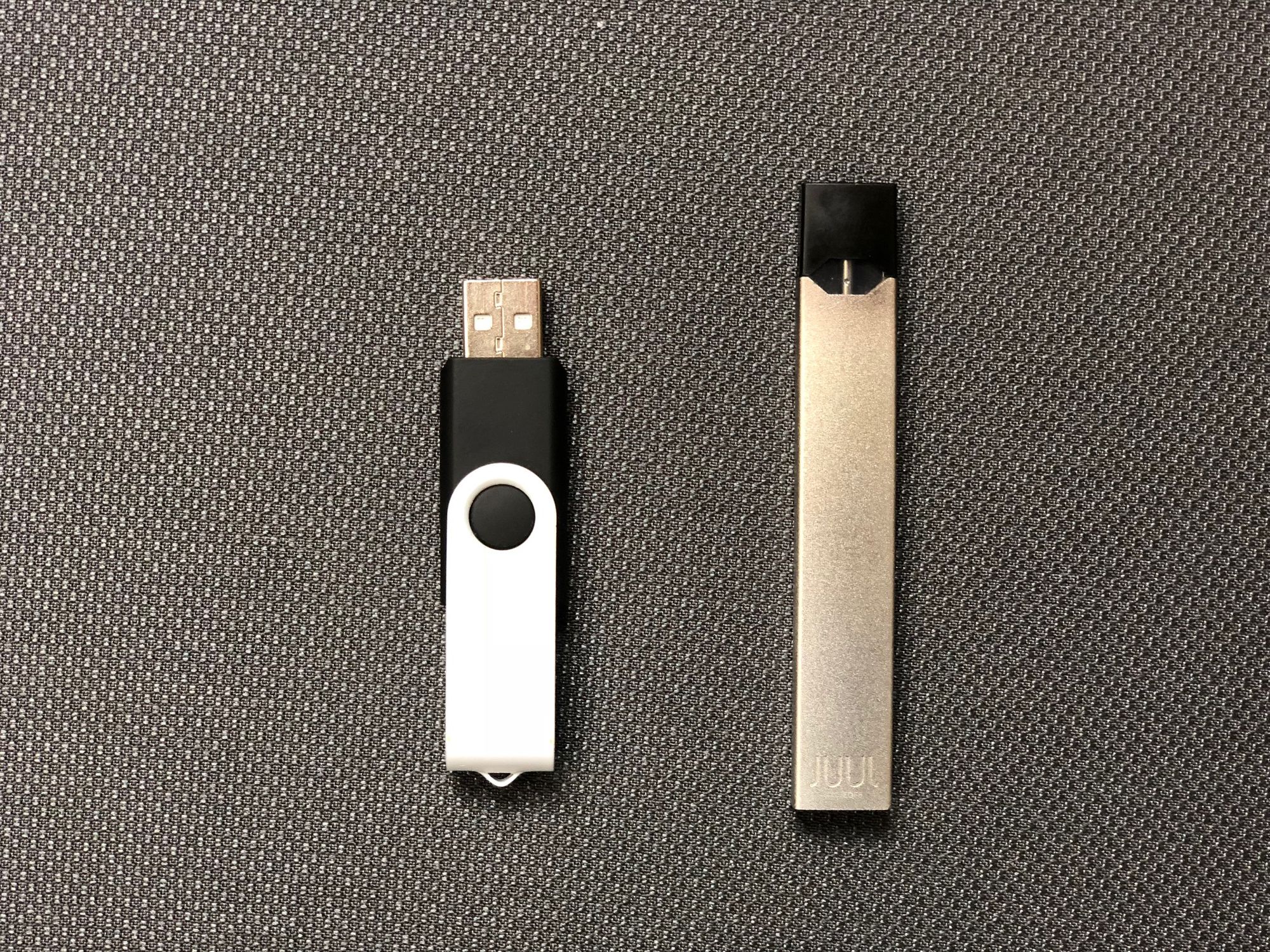School districts from Sioux Falls to Spearfish are grappling with an increase in students who are “vaping” on campus.
Students – some as young as middle schoolers – inhale from hand-held devices that heat liquid gels into an aerosol containing nicotine and flavored compounds.
Generically known as e-cigarettes, the vaping pens and similar devices are legal for adults, some of whom say their use has helped them quit smoking.
But buying, possessing or using vaping devices or gels is illegal for people under 18 in South Dakota and most states.
Research is limited on the effects of heating and inhaling the gels, known as juices, as well as on the long-term impact of regular use. But health advocates are increasingly concerned about vaping, especially by young people who they say are targets of advertising by vaping manufacturers.
Detecting the illegal practice has grown tougher with the entrance of Juul sticks to the market. The thin vaping devices fit in the palm of a hand, require no batteries and release less odor and vapor. They also resemble a standard USB flash drive or memory stick, making them easy to conceal.
With vaping now seen as a status symbol among some youths, a growing challenge awaits parents, teachers and administrators trying to stop the use of e-cigarettes by South Dakota children.

More common than cigarettes
The 1970s song “Smokin’ in the Boys Room” still holds true for Harrisburg High School.
The boys’ restroom is a place where high-schoolers sometimes try to vape on the sly, according to Principal Ryan Rollinger.
“I’ve confiscated a pack of cigarettes maybe once this year,” said Rollinger. “But we’ve had way more vaping products confiscated this year.”
Rollinger said vaping is not an epidemic on campus, but he and other educators are growing concerned.
Spearfish High School principal Steve Morford said he has seen vaping increase on campus recently and has heard of e-cigarette use by middle-schoolers aged 12 to 14.
Like most school administrators, Morford has seen fads come and go, but he is monitoring vaping with a slightly more worrisome eye.
“This one is a little more difficult because the dangers aren’t known or what the long-term effects are, especially for kids,” Morford said. “A lot of kids think it is harmless and it probably isn’t.”
So far this school year, 31 students have been caught vaping in the Rapid City School District, and officials say the number who weren’t caught is likely much higher.
South Dakota is just catching up to a national trend toward increased use of e-cigarettes by young people.
Recent federal reports clearly indicate that e-cigarettes, vape pens and Juul devices are popular among children, and that tobacco use overall remains prevalent.
The 2016 National Youth Tobacco Survey by the Centers for Disease Control showed that e-cigarettes and vaping are now far more common among youths than cigarettes. E-cigarettes, including vaping and Juuling, remained the most commonly used form of tobacco for the third straight year, with 11.3 percent of high-schoolers and 4.3 percent of middle school students reporting they used the products.
Also troubling to the CDC was the finding that among students who reported using tobacco in any form, nearly half said they used two or more different types of tobacco or delivery systems.
Meanwhile, a 2015 study at the University of Pittsburgh showed that in a relatively small sample size of 694 people age 16 to 26, nearly 70 percent of those who used e-cigarettes when the study began had converted to cigarette smoking by the study’s end.

Health concerns growing
Even as tobacco companies, e-cigarette manufacturers and retailers claim that vaping is safe – and even vaping opponents acknowledge it is probably less harmful that cigarette smoking – recent research is pointing to potential health risks of inhaling vaporized nicotine and gels or from the second-hand vapor clouds they create.
A 2015 Harvard University study showed that 39 of 51 samples of vaping juices tested contained diacetyl, a chemical that when inhaled destroys the tiny airways in the lungs, resulting in a condition known as broncholitis obliterans. That potentially fatal condition was also found in workers who prepare microwave popcorn for packaging, giving the condition the nickname “popcorn lung.”
National health and research organizations decrying the use of e-cigarettes include the American Heart Association, American Lung Association, Centers for Disease Control and the office of the U.S. Surgeon General, which in late 2016 released its first detailed report on e-cigarette use by American youths.
The Surgeon General report notes the high rates of use of e-cigarettes by children as young as middle-school age and warns of the growing evidence of health risks.
The report said that in 2015 more than 3 million youths had used e-cigarettes in the past month, with rates highest among males, whites and Hispanics. The report noted that health problems resulting from nicotine use are heightened for young people, whose brains develop until age 25. The report said nicotine use in adolescence can disrupt brain circuits that control attention, learning and susceptibility to addiction. It can also reduce impulse control and cause mood disorders, the report said.
The Surgeon General report, found online at e-cigarettes.surgeongeneral.gov, also notes that in addition to nicotine and diacetyl, e-cigarette gels were found to contain benzene, a component of car exhaust, as well as heavy metals such as tin, nickel and lead.
The report includes a call to action for states, local communities and schools to use many of the same strategies that reduced cigarette smoking among youth, such as higher age limits on purchases, using pricing and tax policies to discourage sales to youths, stricter regulation of marketing to young people and educational initiatives to alert users to the potential dangers.
“We know a great deal about what works to effectively prevent tobacco use among young people,” the report said. “Now we must apply these strategies to e-cigarettes.”
In March, the American Heart Association joined several other health organizations to file a lawsuit demanding that the U.S. Food and Drug Administration reverse an agency decision to delay pre-market testing of e-cigarette products until 2022. The FDA had been set to begin testing vaping products this August.
In South Dakota, the heart association works to educate youth and adults on the potential dangers of e-cigarette use, said Chrissy Meyer, spokesperson for the association in the Dakotas.
The association’s main concerns about e-cigarettes are that the potential dangers of the vapors are not yet fully understood and that e-cigarette use may lead to use of more dangerous tobacco products like cigarettes, especially among youths.
“The products at the center of the lawsuit have become increasingly popular among youth,” Meyer said. “We don’t want to see this as something that starts them down the road to nicotine addiction and tobacco use.”
The heart association shares the worry of many other organizations that e-cigarettes, vaping products and the Juul devices are being marketed specifically to children.
Vaping products often have colorful labels or packaging that makes them look mysterious or stylish. They can be bought at vape shops, convenience stores or online. Facebook pages and websites for vaping shops often exhibit a counter-culture vibe or can appear sleek or a bit spooky. Their messages are clearly aimed at adults but could seem enticing to high-schoolers. Vaping manufacturers have started online networks to make it easy to buy products or find the nearest vaping shop.
Flavors of vaping gels include gummy bear, cotton candy, chocolate, Belgian waffles and even fried Mexican churros. One bottle of nicotine-infused vaping gel confiscated from a Pennington County school student recently was flavored like strawberries and was named “Candy King Belts.”
Vaping and Juuling: A primer for parents
Here are tips for parents to watch for:
- Vaping emits an unexplained pungent, fruity or sweet smell.
- E-juice glass or plastic bottles may look like candy, but ingredients may include nicotine.
- Vaping juices are oily and sticky and pungent.
- Unexpected and discreetly marked packages being delivered.
- Secretive movements and behavior that could otherwise be reasoned away.
- Possessing gaskets and other vape parts the young person cannot explain.
- Adults who vape should keep close tabs on their supplies.
- Monitor behaviors of children as young as middle-school age.
- Vaping may be seen as cool or a status symbol, leading to sudden new friends.
- Parents should clearly communicate their disaproval of vaping.
- For more information, visit e-cigarettes.surgeongeneral.gov.
Source: Pennington County Sheriff’s Sgt. Chris Hislip

‘Parents have to care’
James Luther, co-owner of the Blown Away Vaping store on Minnesota Avenue in Sioux Falls, said early research has shown e-cigarettes to be much safer than cigarette smoke, which he said contains 45 carcinogenic compounds.
The vast majority of their customers use e-cigarettes as a way to slowly reduce their nicotine consumption as part of attempts to quit smoking, Luther said. Flavored e-cigarette liquids that contain no nicotine are one way that smokers can break their cigarette addiction but still satisfy cravings to inhale something and move their hands to their mouths as they did with smoking.
Luther, 65, said he used a vape pen to slowly wean himself away from his nicotine addiction and finally quit smoking. “Personally, I quit smoking after 45 years and trying [nicotine] patches, gum and other things,” Luther said. “I don’t think vaping is a trend. I hope it’s something that eliminates cigarette smoking forever because cigarette smoking is a killer in a lot of different ways.”
He and his wife, store co-owner Sandra Luther, said that young people and their parents should become educated about e-cigarettes, vaping and Juuling. They both said that parental involvement is critical to keeping people under 18 from using e-cigarettes and vaping products.
“It’s just like how you would keep alcohol out of your kids’ hands,” said James Luther, a grandfather of nine. “You have to watch what they’re doing and keep track of them. Parents have to care about what their kids are doing.”
In some cases, however, parents may indirectly exacerbate the problem of underage vaping by taking a relaxed approach to the potential risks of vaping.
When a student is caught vaping, the devices are confiscated and school disciplinary protocols regarding tobacco use are followed, Rollinger, of Harrisburg, said. Often, that includes a conversation with the student’s parents.
“The outlook of most parents is that it’s healthier than a cigarette,” Rollinger said. “When you talk to them about vaping, it seems like there’s a calm. They’re surprised their kid would do it, but I don’t get the same feeling from them when I talk to a parent about cigarettes or chewing tobacco or marijuana.”
The lack of clear, consistent research on vaping, especially compared to the decades of dire reports about cigarette smoking, also gives some parents a sense of security when it comes to their child’s use of e-cigarettes, said Pennington County Sheriff’s Sgt. Chris Hislip, who oversees liaison officers at schools from Hill City to Wall.
“They’ve taken the stance that, ‘Well, I’d rather them be vaping instead of doing something I know is really, really bad,’” he said.
Parents are also less likely to be aware their children are using e-cigarettes compared to combustible cigarettes, especially given the rapid dissipation of e-cigarette vapors and lack of a lingering odor compared to cigarette smoke, Sgt. Hislip said.
The limited amount of vapor and odor from the new Juul pens, in addition to their much smaller size, have heightened the ability of youngsters to hide vaping from parents and teachers, Hislip said.
“With older vape pens, you can usually detect that pungent odor or sweet smell,” Hislip said, “whereas the Juul can be consumed without people knowing it.”
Hislip said the use of vape pens has become a status symbol for some youths. He said students sometimes compete to see who can exhale the largest vapor cloud, blow the most vapor rings or get away with vaping right under the nose of a teacher or school officer. Vape pens can cost as little as $30 and as much as $300; a recent Juul promotion online offered a starter kit for about $40.
Hislip is especially concerned about the Juul devices because the nicotine content of each $4 capsule of gel is equal to the amount of nicotine in an entire pack of cigarettes, about 200 puffs. As with other vape pens, no visible source of flame is needed to vaporize the nicotine, which is heated by replaceable batteries or those recharged by a USB port on a computer.
The single-dose design of the Juul pens means that a user will consume every bit of nicotine present, whereas much of the nicotine in cigarettes burns off when not being inhaled.
“The industry is not really regulated, so sometimes it’s hard to get a sense for how much nicotine a kiddo is actually consuming,” Hislip said. “There are concerns we could have nicotine overdose or that a kid could be more likely to get addicted because they’re getting a concentrated dose of nicotine.”
To alert Pennington County school officials and employees about how to spot the Juul pens, Hislip sent out an email this spring with photos of the Juul devices and tips on how to recognize their use. Hislip said he knows of three incidents in the Rapid City schools in which Juul devices have been confiscated this school year, which he said indicates many more are being used but not being discovered.
School officials across the state have sent similar emails about Juul pens but also about vaping in general to educate teachers and staff. Another common concern is that vape pens can be used to smoke marijuana and derivative products and further conceal use of the drug.

Limited state laws
Operators of vape shops and convenience stores say they are diligent in checking customer IDs before selling e-cigarette products, just as they do before selling alcohol or other age-restricted products like smokeless tobacco, cigarettes or cigars. But online sellers have no way of knowing the age of their customers, and most only require patrons to click a box promising they are over 18 before proceeding to the purchase point.
“Much of this stuff can be bought online and the safeguards to prevent minors from obtaining the products are pretty weak,” said Sgt. Hislip.
South Dakota made it illegal to sell e-cigarettes or vaping products to people under 18 in 2014. The only other South Dakota law related to e-cigarettes outlawed the sale of opened packages or in vending machines that are located in places where patrons under 18 are allowed.
Most states restrict e-cigarette sales to minors, but few have laws about where vaping can take place.
South Dakota laws exclude e-cigarettes or vaping from the statewide ban on smoking in public buildings or workplaces, including bars and restaurants. While language in statute 34-46-20 adopted in 2014 indicates that “the term tobacco product includes vapor product,” it goes on to say that vaping is a “noncombustible product containing nicotine.”
In North Dakota, state laws banning cigarette smoking in public places and workplaces specifically make e-cigarettes and vaping subject to the ban. Smoking and vaping is also illegal within 20 feet of entrances, windows, air intakes or ventilation systems of public buildings and workplaces in North Dakota.
Very few proposals to regulate e-cigarettes have been considered in South Dakota. A proposal to raise the age limit on tobacco sales from 18 to 21, including for e-cigarettes and vaping products, failed in the House of Representatives on a 45-21 vote in February.
Republican Rep. Leslie Heinemann said he sponsored the bill as a way to make it harder for young people to obtain tobacco products and as a way to prevent more people from taking up smoking or tobacco use in any form.
Heinemann said he intends to bring the bill back next session but may try to raise the minimum age from 18 to 19 instead of to 21. Heinemann said that would make it harder for minor students to get cigarettes or e-cigarettes from their classmates who have turned 18 during their senior year in high school. He said he believes that vaping is probably safer than smoking cigarettes, but he said he is concerned that any consumption of nicotine can lead to an unhealthy addiction. “The lung cancer issue isn’t quite as extreme,” he said. “But with vaping, there’s going to be some addiction associated with the nicotine and they’ll get it in other ways if they have to.”




